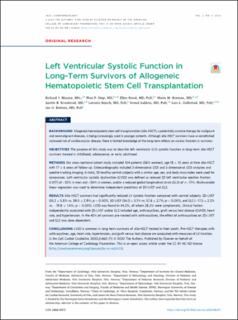| dc.description.abstract | Background
Allogeneic hematopoietic stem cell transplantation (allo-HSCT), a potentially curative therapy for malignant and nonmalignant diseases, is being increasingly used in younger patients. Although allo-HSCT survivors have an established increased risk of cardiovascular disease, there is limited knowledge of the long-term effects on cardiac function in survivors.
Objectives
The purpose of this study was to describe left ventricular (LV) systolic function in long-term allo-HSCT survivors treated in childhood, adolescence, or early adulthood.
Methods
Our cross-sectional cohort study included 104 patients (56% women), age 18 ± 10 years at time allo-HSCT with 17 ± 6 years of follow-up. Echocardiography included 2-dimensional (2D) and 3-dimensional (3D) analyses and speckle tracking imaging. In total, 55 healthy control subjects with a similar age, sex, and body mass index were used for comparison. Left ventricular systolic dysfunction (LVSD) was defined as reduced 2D left ventricular ejection fraction (LVEF) of <52% in men and <54% in women, and/or a reduced global longitudinal strain (GLS) of ≥−17%. Multivariable linear regression was used to determine independent predictors of 2D-LVEF and GLS.
Results
Allo-HSCT survivors had significantly reduced LV systolic function compared with control subjects: 2D-LVEF (55.2 ± 5.8% vs. 59.0 ± 2.9%; p < 0.001), 3D LVEF (54.0 ± 5.1% vs. 57.6 ± 2.7%; p < 0.001), and GLS (−17.5 ± 2.2% vs. −19.8 ± 1.4%; p < 0.001). LVSD was found in 44.2%, of whom 28.3% were symptomatic. Clinical factors independently associated with 2D-LVEF and/or GLS included age, anthracyclines, graft versus host disease (GVHD), heart rate, and hypertension. In the 45% of survivors pre-treated with anthracyclines, the effect of anthracyclines on 2D-LVEF and GLS was dose-dependent.
Conclusions
LVSD is common in long-term survivors of allo-HSCT treated in their youth. Pre-HSCT therapies with anthracyclines, age, heart rate, hypertension, and graft versus host disease are associated with measures of LV function. | en_US |

